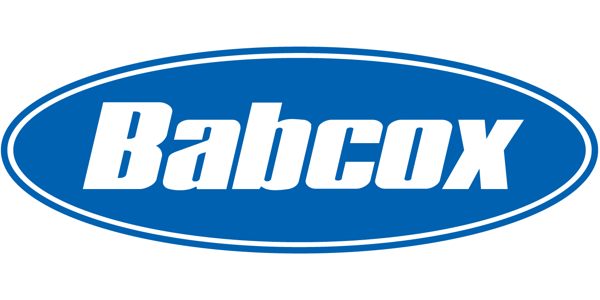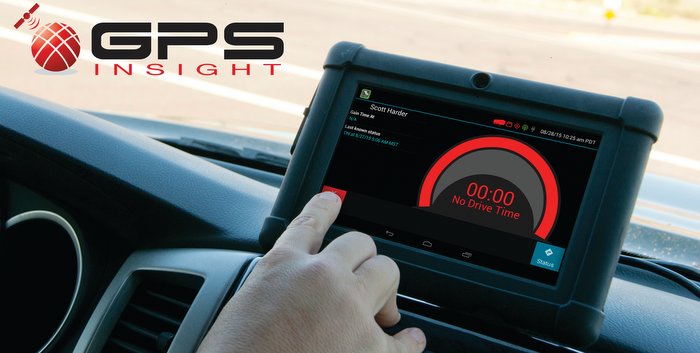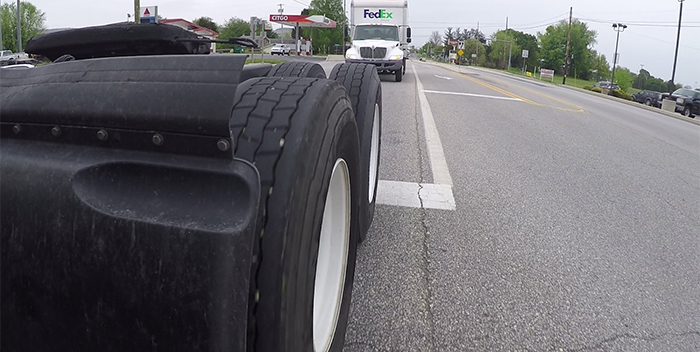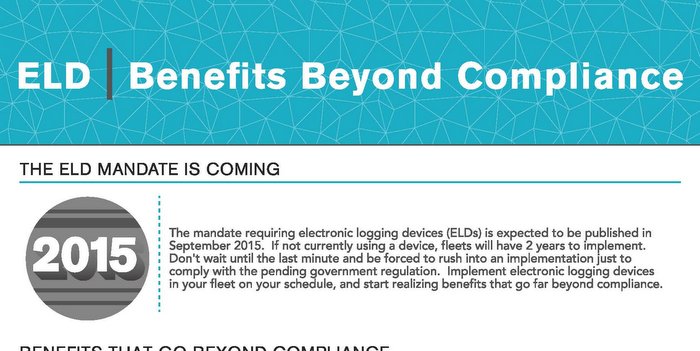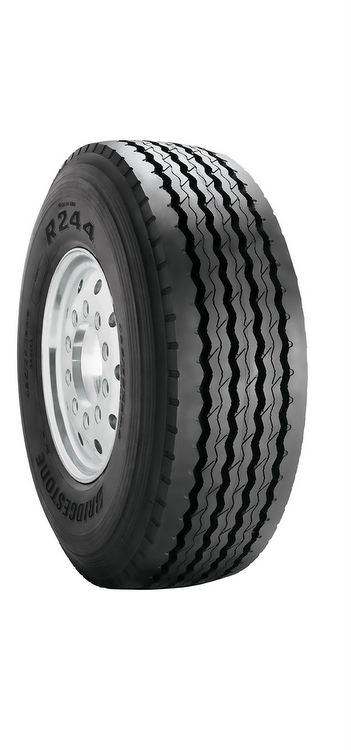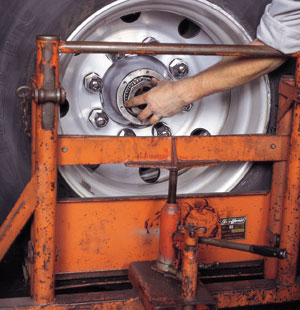 Wheels that have been in service need to be inspected at regular intervals to assure proper and safe performance. Routine maintenance and proper use will prolong wheel life. It is not always possible to predict the useful life of a wheel; wheels will eventually wear out.
Wheels that have been in service need to be inspected at regular intervals to assure proper and safe performance. Routine maintenance and proper use will prolong wheel life. It is not always possible to predict the useful life of a wheel; wheels will eventually wear out.
Alcoa Wheel Products experts note that, generally, older wheels and wheels operating in extreme conditions should be examined more frequently for obvious signs that they should be removed from service. Examine all exposed areas frequently. Clean wheels and look for cracks or other damage. Also, check the inner dualed wheel when the outer wheel is removed.
Tire change checks
During tire changes, thoroughly examine the entire wheel. Pay particular attention to the rim contour and the surfaces of the rim, Alcoa suggests. Always check wheels for hidden damage. Here are some guidelines to follow:
• Do not exceed the maximum wheel load. Compare OEM vehicle load rating to maximum wheel load rating.
• Do not over-inflate tires. Use the tire manufacturer’s recommended pressure, but under no circumstances exceed cold tire pressures.
• Before mounting the tire, perform a wheel fitment check to ensure proper clearance from any obstructions. Some forms of wheel damage can be hidden beneath the tire, so whenever a tire is removed, thoroughly examine the complete wheel. Remove all grease and road dirt. Use a wire brush or steel wool to remove rubber from the bead seats.
• Check mounting holes for enlargement and elongation, which can occur if the cap nuts are not kept tight. Dirt streaks radiating from stud holes may indicate loose cap nuts.
• Wheels should not be painted, or otherwise coated, in any way that may interfere with the mounting surfaces. Wheels that show signs of alteration should be removed from service and scrapped.
• Inspect for exposure to excessive heat. A wheel that has been subjected to excessive heat may appear charred or burned. A wheel that has been exposed to excessive heat may appear to be in good condition if it has been cleaned. Do not use any wheel that has been overheated, regardless of appearance.
Simple and quick hub/stud maintenance suggestions
Ken Kelly, vice president of Webb Wheel Products, Inc.’s aftermarket business unit, says “In any given year, there’s a good chance you’ll pull a tire and rim assembly from your truck or trailers to replace worn tires or to repair an unexpected road hazard. While the tire/wheel assembly is off the hub, fleet technicians should seize the opportunity to perform some routine hub maintenance procedures that only take a brief moment and involve simple and readily available tools found in most shops.”
While axle hubs are designed to run for the life of the vehicle, they do require periodic maintenance. Most of today’s vehicles utilize hub piloted disc wheels, where the disc wheels are centered using precision-machined pilot pads on the hubs. Any buildup of corrosion, dirt, debris or foreign material can affect the mating between the disc wheel and the hub. If the disc wheels are not centered properly, it can lead to balance complaints and may also affect tire wear. The simple solution is to use a common wire brush every time you have access to the hub to ensure the machined pilot pads are clean and free of corrosion or damage. This is especially true for vehicles that travel through snowbelt regions and use magnesium chloride or potassium chloride for snow/ice removal. Although these materials are great for keeping the roads clear, they can wreak havoc on vehicle components due to accelerated corrosion rates.
While you’ve got that wire brush in your hand, it’s an excellent time to ensure the threads of the wheel studs are cleaned and free of debris. Wheel studs do have a finite life span, but their service life is dependent on how well they are routinely maintained. Industry-standard installation torque values are based on a clean threaded joint with the factory-standard coatings. Over time, these fasteners also come under attack by magnesium chloride or potassium chloride. During each hub piloted disc wheel service interval, use a clean wire brush to remove any surface corrosion and apply two drops of SAE 30W oil to the leading threads to restore the original lubrication characteristics. It’s important to understand the recommended amount is just a few drops. Excessive lubrication is not recommended and adversely affects the integrity of the bolted joint at recommended torque levels. In this case, “more” is definitely not better.
Kelly notes that taking a brief moment to perform these simple maintenance procedures during tire/wheel removal with basic shop tools of a wire brush and oil dropper will go a long way toward maximizing the service life of axle hubs and wheel studs.
(These recommended maintenance procedures, along with a host of other wheel end fastener maintenance guidelines, are available in Technology and Maintenance Council’s Recommended Practice RP-656 Hub and Spoke Wheel Fastener Maintenance.)
Installing Brake Drums
Motor Wheel suggests the following two important maintenance tips:
1) When installing a brake drum, it is important to locate one hub pilot pad at the 12 o’clock position. Before mounting the wheels, be sure the brake drum is properly positioned on the raised step of the pilot pad. With wheels square to the hub, mount the inner and outer wheels as far back as possible on the pilot pad. Finger tighten nuts first at the 12 o’clock position, then the 6 o’clock position, then follow the remaining sequence. The most common cause of improper brake drum mounting is not locating one hub pilot pad at the 12 o’clock position when mounting the drum. This causes the brake drum to be slightly cocked, and may not be noticeable to the naked eye. Sometimes this condition is confused with the brake drum being out of round, when in fact it is not, it has only been mismounted.
2) Make sure to achieve proper torque when tightening nuts (450 to 500 ft./lbs.) to prevent wheel-off conditions. Over torquing can cause a stud to stretch beyond its yield and lose torque and clamp load. Loss of torque and clamp load causes wheel studs to break from bending fatigue.
It’s all about the fit
Timken reports, to help ensure proper bearing function, it is important to mount a wheel bearing with the proper fit. Generally, rotating members are installed with tight or press fits (known as interference fits), while stationary components can be either tight- or loose-fitted, depending on the application. In heavy-duty truck wheel ends, the cup, or outer race, has a tight fit, while the cone, or inner race, typically has a loose fit. Tight fits keep the rotating bearing component (cup) from turning in the housing (hub). When the bearing cup turns in the hub, it wears away the hub inside diameter (ID) and backing shoulder, creating debris particles, which can cause seal wear and leaks; bearing race, rib and roller wear; and weakening of the hub. These wear particles also can oxidize in the lubricant. Wearing of the hub ID (at the bearing locations) also increases the hub bore and results in an out-of-tolerance hub. For this reason, the hub ID should be measured when the bearings are removed for service. If the hub ID is larger than the OEM’s specifications, the hub should be replaced.
Loose fits are used on the stationary component (cone). The loose fits are used primarily to accommodate ease of assembly and bearing adjustment. The loose fit allows the cone to easily slide along the shaft as the nut is tightened during bearing adjustment. Excessively loose fits should be avoided or misalignment may occur within the wheel-end.
Misalignment will prematurely wear out the bearings and seals. Similar to the hub ID, the spindle diameter should be measured during wheel-end service to ensure that there is not excessive spindle wear. Inspect the top and bottom of the spindle because the under side may show wear when the top half appears new. If the spindle diameter is out of the original manufacturing specifications, the spindle should be replaced.
Fitting practices mainly depend upon the following parameters:
· Application
· Rotating or stationary components
· Running condition (shocks, vibrations, overloading or speed)
Basic maintenance
Leslie Kern, SKF product development manager, heavy-duty, details basic maintenance procedures for wheel ends:
Level 1: Pre-trip (in-service)—Prior to every trip or when a driver returns to a vehicle while in service. Inspect as soon as the vehicle is stopped:
• Feel hubs, taking care not to burn yourself, for excessive heat or variance in temperatures between wheel ends.
Inspect prior to (re)entering the vehicle:
• Visually inspect each wheel end for loose, damaged or missing fasteners.
• Inspect each hubcap for sufficient lubricant level, missing or loose bolts or plugs.
• Check for leaks by looking for wetness at hubcap gasket, axle flange gasket or seal, hub or brake lining. Wetness at the hubcap plug or hub vent is not an indication of a leak.
If any of the above conditions exist, take appropriate actions, including placing the vehicle out of service if need be.
Level 2: Detailed inspection should be carried out annually or every 100,000 miles (whichever comes first), as follows:
• Conduct all of the inspection criteria listed under Level 1.
• For oilbath non-driven axles, check lubricant fill level and condition. If lubricant is in good condition but low, fill to proper level using the same lubricant within the wheel end. If lubricant contains contaminants such as water (milky or white appearance) or debris (gritty), replace lubricant with same lubricant type within the wheel end. A magnet may be used to find metal particles.
• For semi-fluid grease non-driven axles, pull the outer bearing and inspect lubricant level and condition. Use OEM recommended fill level or 3 o’clock /9 o’clock as prescribed by Technology and Maintenance Council (TMC). Replace lubricant if contaminants are found as recommended above.
Reduce wheel-off incidents
Wheel Torque Solutions brings together the optimum nut, bolt, wheels, tools and processes for increasing torque retention, reducing the potential for costly and dangerous wheel-off incidents. This collaboration increases safety by reducing the potential for wheel-offs through increased torque retention. The solution’s clearly-defined installation process and tools significantly reduce the potential for human error that can result in costly and dangerous wheel-off incidents, according to Alcoa.

